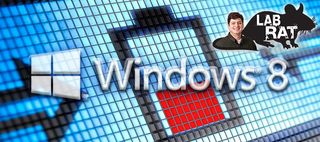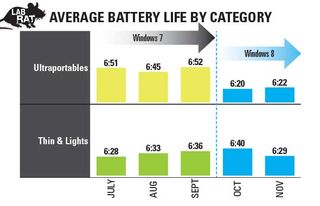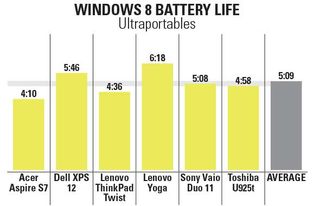Short Battery Life Sinks First Windows 8 Notebooks

Confusing dual-mode operating system, no Start button, counterintuitive swipe gestures? None of these things spells doom for Windows 8. What will kill Microsoft’s newest operating system is the abysmal battery life of the systems on which it’s supposed to perform the best.
Leading up to the launch of Windows 8, we saw progressively longer endurance on the two most-portable categories of notebooks. As of September, the average ultraportable (a notebook with a screen size of 11 to 13 inches and weighing less than 4 pounds) lasted 6 hours and 52 minutes on the LAPTOP Battery Test (Web surfing via Wi-Fi, screen at 40 percent brightness). The average thin-and-light (12 to 14 inches, less than 6 pounds) was right behind, at 6 hours and 40 minutes.

However, when we started adding Windows 8 notebooks to the mix, those averages receded faster than Steve Ballmer’s hairline. By November, the ultraportable average dropped by half an hour, and the average thin-and-light decreased by 10 minutes.
[More: Windows 8 OS Full Review]

Of the first 11 Windows 8 laptops/sliders we tested, most of which were ultraportables, six lasted fewer than 5 hours on a charge, and only two made it past 6 hours. The average of all these systems: 5 hours and 8 minutes. That’s hardly what I’d call all-day endurance.
Even our favorite Windows 8 notebooks had sub-average endurance. The Dell XPS 12 lasted 5 hours and 46 minutes, and the Lenovo IdeaPad Yoga died after 6 hours and 18 minutes.
The cause, of course, could have been a number of reasons: Windows 8, touch screens or both.
Stay in the know with Laptop Mag
Get our in-depth reviews, helpful tips, great deals, and the biggest news stories delivered to your inbox.

Let’s compare the Toshiba Satellite P845t-S4310 and the Toshiba Satellite P845-S4200. Both notebooks have the same CPU, RAM and hard drive, but only the former has a touch screen and Windows 8. And guess what? The non-touch, Windows 7 version lasted 1 hour and 24 minutes longer.
Next, there’s the HP Envy 4-1030US Ultrabook and the Envy TouchSmart Ultrabook 4, which also have identical specs. Battery life: 6:18 for the Envy 4 versus 5:36 for the TouchSmart. How about the Acer Aspire V5-571P versus the Acer Aspire V5-571, which also have the same CPU? Interestingly, both have an equally poor endurance of about 4 hours and 10 minutes.
The worst offender is the Acer Aspire S7, a 13-inch ultraportable that costs $1,699 and weighs a mere 2.8 pounds, but lasted just 4 hours and 10 minutes. For that much money, I expect at least twice the endurance. There’s an optional $150 sheet battery for the S7 (which adds to its size and weight, natch) that Acer should consider including for free.
To be sure, this is a fairly small sample size, but these are the notebooks that are supposed to get consumers excited about Windows 8. You would think that notebook-makers would want to put their best foot forward, no?
Microsoft isn’t helping matters, either. Their just-announced Surface Pro tablet, the flagship Windows 8 device, will have an expected battery life of just 4 hours. I’ve heard the company boast that the Surface is the first tablet you can actually do work on. Not if it’s out of juice, you can’t!
A number of challenges face OEMs and Microsoft when it comes to the adoption of Windows 8, from design to pricing. But solving all those issues will be moot until they fix the most basic requirement for any laptop — good battery life.
Reviews Editor Michael Prospero oversees every product reviewed by LAPTOP Magazine. Read his regular column and follow @mikeprospero on Twitter.
